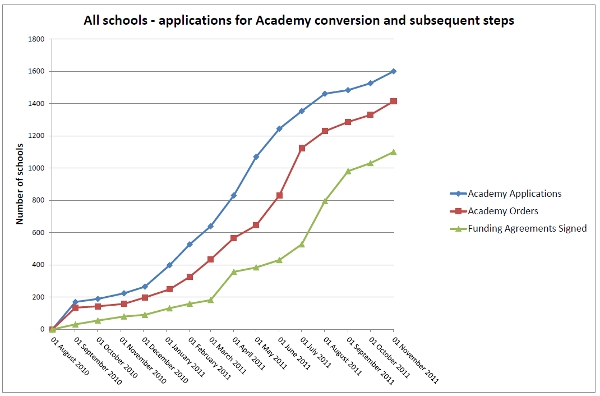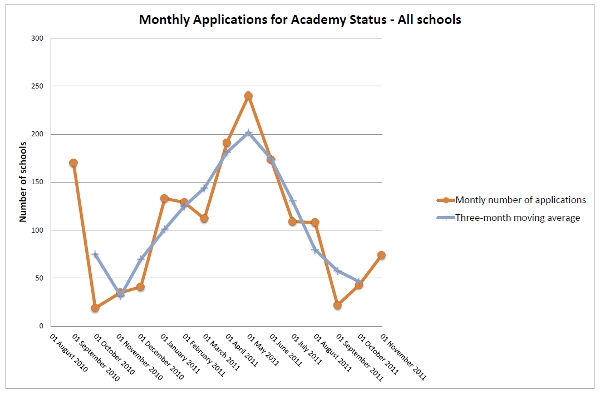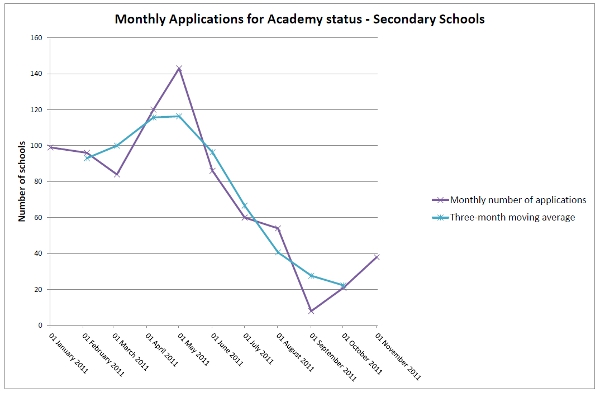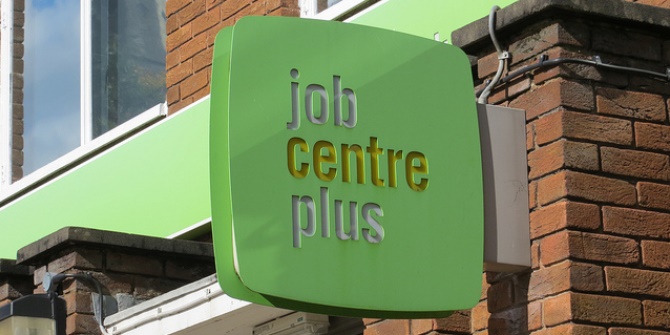 Introduced by the Labour government in 2002, the campaign to convert schools to Academy status has been taken up with considerable gusto by the Education Secretary, Michael Gove. Using data provided by the Department for Education, John Fowler finds that while there were considerable applications for conversion to Academy status in the spring, the number of applications have now dropped significantly. It may take decades before all schools achieve Academy status.
Introduced by the Labour government in 2002, the campaign to convert schools to Academy status has been taken up with considerable gusto by the Education Secretary, Michael Gove. Using data provided by the Department for Education, John Fowler finds that while there were considerable applications for conversion to Academy status in the spring, the number of applications have now dropped significantly. It may take decades before all schools achieve Academy status.
“Come on in. The water’s lovely” was Secretary of State, Michael Gove’s answer when asked by ardent Academy supporter, Richard Fuller about schools which “have not yet got up the nerve” to convert to Academy status at Education Questions in the Commons on 21st November 2011. Meanwhile, the Times Educational Supplement had, a week earlier, declared that “the widespread adoption of Academy status has done more than anything else to emasculate what was left of local (government) education departments”.
One of the government’s flagship policies, which was rammed through Parliament using procedures normally associated with emergency legislation in summer 2010, is to allow schools to become independent of local authorities in exchange for additional resources but more central control. While the government shows much commitment to promoting Academy status, little research has been undertaken on the extent of the changes and the effects conversion has on the local school and the complex web of relationships which ensures that there is a school place for every child and school improvement across an area are pursued. Although we cannot answer the question “Is anyone drowning yet?” the research available does give an idea of the national picture and points the way for further research.
Using Department for Education (DfE) data on applications, we can track trends in applications for Academy conversions over the 15 months of the programme. There was a significant increase in the spring 2011, but the number of applications is now roughly between one-quarter and one-fifth of the rate it was then. Figure 1 shows the steep increase in the rate of applications in the spring and the levelling off in recent months (although there was a slight increase in the rate of applications during October). The horizontal distance between the applications and the signing of the funding agreements gives an indication of how long the process takes. Currently on average it takes 6 to 7 months to convert a school, considerably longer than the DfE’s stated 3 to 4 months.
Figure 1

Figure 2 shows that the current rate of applications is about one-quarter of what it was in the spring:
Figure 2

Looking more closely at applications by type of school, Figure 3 shows applications for academy status by primary schools. Roughly 20 schools are applying each month although there was an increase in October. The number of applications is again roughly at about one-quarter of the level of applications in the spring.
Figure 3

The January 2011 census reports that there were 16,884 “state funded” primary schools of which 37 were academies. The number of applications from primary schools stood at 508 on 1 November 2011 of which 321 had signed funding agreements. This leaves 16,339 maintained primary schools which had not indicated whether they wish to convert although it is almost certain there will be have been the normal opening and closing of approximately 50 primary schools at the end of the last school year. On current trends, it would take in the region of 65 to 70 years for all primary schools to convert to academy status.
Figure 4 shows a similar steep decline in secondary school applications from the spring but also a small increase during October. The number of secondary school applications (not including middle-deemed secondary) on 1 November 2011 was 1007 of which 738 had signed funding agreements.
Figure 4
The number of “state-funded” secondary schools reported in the January 2011 census was 3,310. This will include the three CTCs/CCTA, 97 converted secondary academies (there were no converted middle-deemed secondary in January) and 271 sponsored secondary academies giving 2939 local authority-maintained secondary and middle deemed secondary which could convert to academy status. However, there have been 44 applications from middle-deemed secondary and 910 applications both before and subsequent to the January census and 48 new sponsored academies many of which will replace an existing maintained school. This gives a figure of 1937 maintained secondary and middle deemed secondary schools which have not yet indicated whether they wish to convert to academy status – approximately 60% of all state funded secondary education. On current trends, it would take in the region of 7 to 8 years for all secondary and middle-deemed schools to convert to academy status.
It spite of Mr Gove’s offer to join him in the water, the DfE has not published any targets for conversion of maintained schools although the planning assumptions behind the academies act stated that the department was planning for 200 conversions per year, a gross underestimate. The importance of this policy, controversial as it is, to the Coalition Government is not to be doubted. It was in one of their first Bill laid before Parliament and has dominated the media headlines ever since.
However, what is clear is that the initial enthusiasm for Academy conversions has waned considerably. With any new venture like this, there will always be schools and their head teachers who wish to be first on the block, especially with the additional resources on offer. The reality of what it means is probably now dawning on some schools with the consequent reduction in the enthusiasm. The late spring 2011 change to the rules about which schools can be “preapproved” for Academy status which increased the pool of potential converts has not increased the number wishing to convert. (Initially only schools with an outstanding Ofsted rating could be preapproved; now virtually any school can apply for Academy status although low performing schools will be required to partner with an outstanding school.)
What is clear though is that as far as secondary education is concerned, with 40% of the schools on their way to Academy status, it will change the landscape, and role of local government, for a long time. Little research has been done on the geographical distribution of the schools; it is likely that there is a high proportion in a few authorities and a further blog will look at this. Whether the local authorities are attempting to preserve some of the cross-area services and school support services either by selling to academies or establishing (or staff establishing) a social enterprise organisation to deliver services is not known.
It is also clear that primary education has hardly been touched by conversions to Academy status although it is possible that some areas have concentrations of primary Academies. There are many schools out there still resisting a swim with Mr Gove, and local government education departments are not yet emasculated (although some will have to become primary orientated).
___________________________________________
 John Fowler – Local Government Information Unit
John Fowler – Local Government Information Unit
John Fowler is a policy manager within the Local Government Information Unit specialising in education and children’s services. He has worked in management, performance and policy roles in seven local authorities in London and the south east. He was deputy head of education, culture and tourism at the Local Government Association from 1997 to 2002. He has also contributed to books on the role of the local authority in educational provision, data and school performance, and rights in education.







